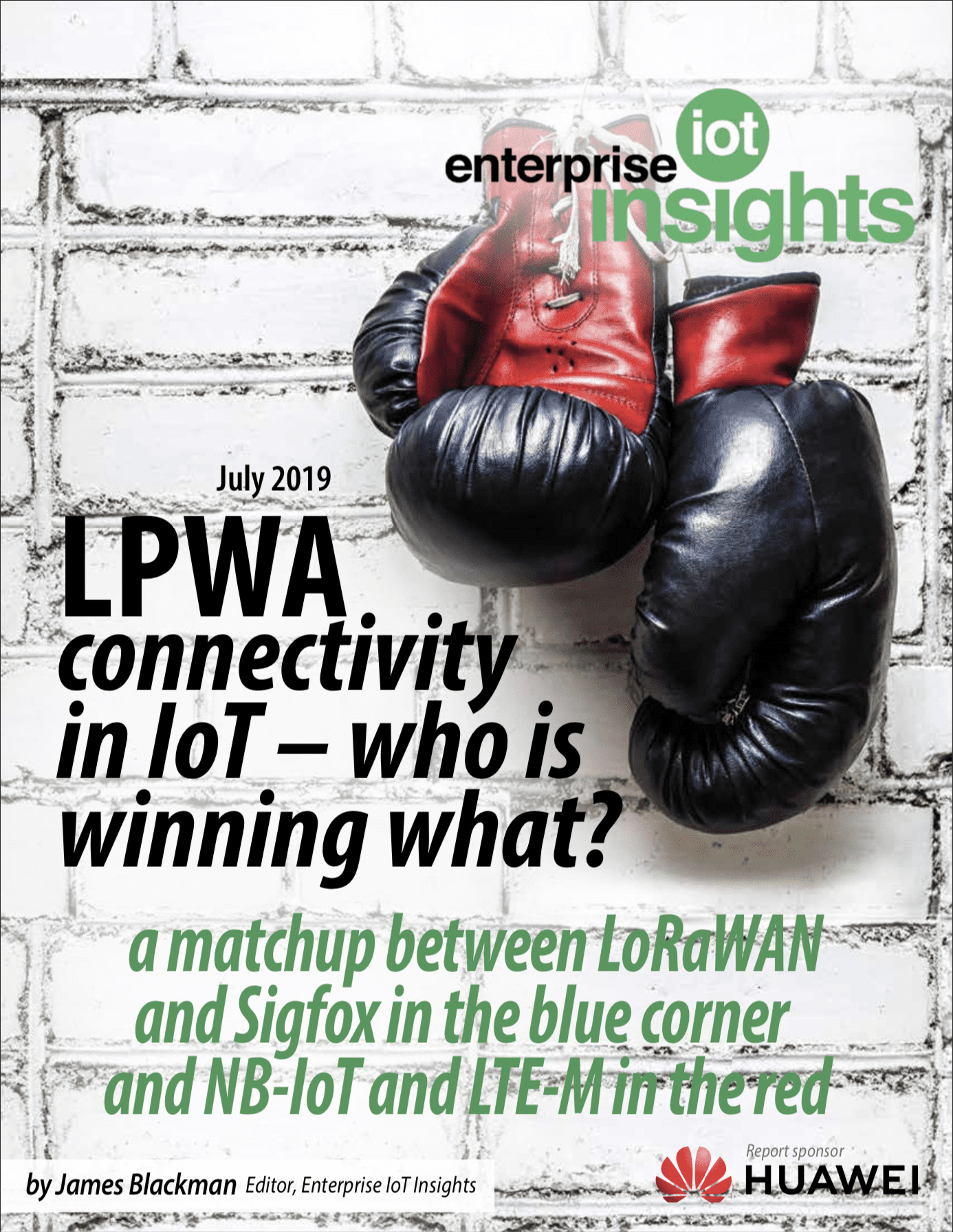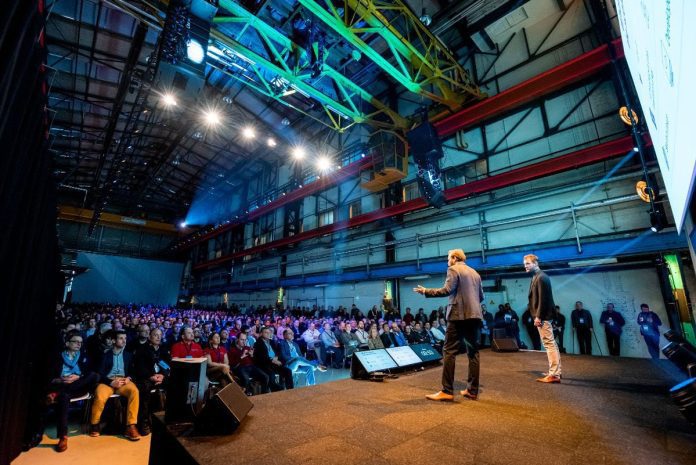An intro-video plays as the founders of The Things Network (TTN), take to the stage at their annual LoRaWAN bash in Amsterdam. A Hollywood-style voiceover crows about big-sounding tech – something about 5G and 0G, and all the other Gs – before the baritone unravels, the music falters, and the fanfare stops.
“Gee-eze,” says the voice, suddenly deflated. Laughter breaks out. The audience, massed in a makeshift conference hall in an old warehouse on the Amsterdam waterfront, recognizes the absurdity of the video-bluster and cheer-leading that attends equivalent showcases on the conference circuit.
This event, The Things Conference, in its fifth year, is different, it claims. It seeks to deal with the technical challenges of working in, and the business of making money from, the much-hyped and rather-troubled IoT sector. There is some relief in the laughter, too, that these headaches will be addressed.
“We wanted to cut through the hype. Because, you know, if you go to MWC, that’s an old boys’ club. The cards have already been dealt,” explains Wienke Giezeman, one of the founders of TTN, speaking off-stage afterwards, and a couple of weeks before MWC 2020 is kicked into touch by fear of coronavirus.
“MWC is this fancy show, run by marketers. People don’t go because they want to; they go because they don’t want to miss out,” he says. We should put that in context: Giezeman wants to go to Barcelona; he was scheduled to give a talk at MWC, at the time of this interview, and regrets its cancellation, now.
But most of the IoT sector, as it stands, has developed apart from the old telecoms market, with a DIY punk ethos sprung from cheap non-cellular low-power wide-area (LPWA) technologies like LoRaWAN and Sigfox, and mesh-able IEEE protocols like Bluetooth, Wi-Fi, and Zigbee.
These are the technologies that have animated most IoT sensor networks, to date; not new-ish LTE-based LPWA technologies like NB-IoT and LTE-M, not 4G LTE, itself, and not 5G at all, yet. Hardly, anyway; these technologies are coming, and will have their places. They will expand the market, crossing over with and robbing share sometimes from these others.
But the LoRaWAN community, for example, has grown as a collective, in the shadow of the telecoms market, and finds itself each year tucked away in Hall 8 of the Fira at MWC, while the giants of the industry sell their version of the future in 3 and 4.
The rest of the IoT sector, uniting far-sighted startups and keen-eyed corporates, is bounded by its “vulnerability”, says Giezeman – by its joint work to turn its failures into successes. This is the “real life” of IoT, he says, and headline events like MWC do not really serve. His event is different, he says.
“What drives us is this vulnerability – that 80 per cent of the IoT use cases fail. Because what happens if you screw up all your IoT projects? It is a bad story, but it is also the real life of IoT. The market needs to come together, and share its experiences. Because you can help others, to help grow the market. That’s what I mean by vulnerability – because it’s scary to say you failed.”
Giezeman references research by McKinsey & Company that says the number of IoT projects, rather than the volume of IoT revenues, will come to define success for IoT providers. “The more you can screw up, without going bankrupt, the better you will be. That represents real validation of this idea we are still in a learning phase, and we should learn together and make the market together.”
We should talk 5G and 0G, presented alternatively by the operator community and LoRaWAN rival Sigfox as cure-alls for IoT, and subjects, both, of mischievous digs from the noisy LoRaWAN crowd during the curtain-raiser in Amsterdam.
What, then, do these technologies stand for, and what is their place in the market? Surely, in the end, each technology will have its place? That is the default line from the the 5G and Sigfox sides, in the press anyway, which at least grasps at magnanimity. It is Giezeman’s take, as well. “There is no silver bullet, there is no secret sauce, there is no fairytale,” he says.
“It is a fragmented market, with a lot of different problems, with lots of different contexts, all of which require different solutions and technologies. If it was only so simple, that one technology could rule them all, or one platform could rule them all. It is not.”
But he is vexed that 5G is used as an “umbrella term” in public discourse, as just that: as a single pass to a fairytale world of new economic growth. “5G is a commercial term, promoted by a commercial alliance, the GSMA – which is a front for the world’s mobile operators,” he says.
“And it has done its job so well because 5G is now in the mouths of politicians. We have politicians saying, ‘We need 5G, because…’. I mean, do politicians ever talk about Coca-Cola? Do they every say they need Cisco?
It becomes confusing, because people say, ‘Yeah, but 5G does it all, and it changes over time’. It is just an umbrella term, to say, ‘No worries, we will solve it all’. It is presented as a silver bullet, which it is not. I mean, I think it’s awesome we throw more capacity at the market. I think 5G is cool, but maybe the marketing around it should be more honest.”
TTN, with its spinoff industrial group The Things Industries (TTI), might be described as a scale-up, managing 18,000-odd LoRaWAN gateways on 500,000-odd LoRaWAN networks, globally. But its influence in the LoRaWAN community is significant.
The Things Conference has become a key fixture in the LoRaWAN calendar. Semtech, which licenses LoRa-based chips for use on LoRaWAN networks, and the LoRa Alliance, the community’s own GSMA, both saved announcements and made appearances at the Amsterdam event.
LoRaWAN will work in the 2.4 GHz spectrum band, also occupied by Wi-Fi and Bluetooth systems, to enable LoRaWAN-based IoT devices to work globally at the same frequency for the first time, without needing to switch between sub-GHz bands in roaming, the conference was told.
New 2.4 GHz LoRa gateways and devices will start to hit the market through 2020, with the first 2.4 GHz LoRa gateway from MultiTech Systems already available, and the first 2.4 GHz LoRa deployment live with maritime group Wilhelmsen’s shipping fleet, as announced at the end of 2019.
TTN co-founders Giezeman and Johan Stokking reflected the LoRaWAN industry had evolved out of an “open standards and hard work” – as well as an “accumulation of screw-ups” – to reach some maturity, with network deployments going from only hundreds of gateways a couple of years back, to thousands in 2019, and hundreds of thousands at the start of 2020.
They had their own announcements, too, around a new peering service to unite and bolster disparate LoRaWAN networks, and a tie-up with Lacuna Space to route LoRaWAN traffic via its new satellite installation into ground-based LoRaWAN systems.
As well, they introduced secure hardware elements for LoRa-based devices and a new Join Server component in TTN LoRaWAN networks. Combined, these offer secure storage of root keys on open LoRaWAN devices, which can change the network server provider, and simpler key management.
The message, in Amsterdam, is the formative IoT market, buoyed by low-level sensor applications and open standards, and well-served already by the LoRaWAN collective, has so far existed apart from the closed-shop of mainstream telecoms. It will continue to seek to solve and popularize IoT cases together, as a community, comments Giezeman.
“We are open – that is the core of our philosophy. The value comes from sharing the pie. The complexity of IoT is such that you will end up with all these failed, non-scalable proofs if you go it alone. Everybody should do what they’re good at, and use agreed-upon open APIs to work together,” he says.
“And that’s not new, actually. People think it is somehow revelatory. It’s not – it’s the same reason your laptop works, and you can hop onto Wi-Fi over here to access email over there. Because everyone is using the same standards and interfaces.”
There is degrees of openness, of course, which can be argued various ways. LoRaWAN works with proprietary chipsets, licensed by Semtech. Everything is open in the network on top, which are strung together like a global patchwork. Sigfox, by contrast, controls the network layer, appointing approved operators in each market, with “borderless” interoperability as a meaningful upside.
The traditional telecoms, rolling out NB-IoT and LTE-M to capture low-level LPWA business, comes at it with all its weight. But the cards have been dealt, Giezeman’s argument goes. He explains the tradeoff, and the sense of sharing code and systems, even at the price of cannibalizing revenue share, in order to make the pie bigger.
“Proprietary solutions make sense, in lots of ways, to protect your business case. But they are limiting at the same time – because they break this network of things. It sounds scary, perhaps, to let others in, and to ride on the back of your own investments. But that way creates additional demands. It creates the market,” he says.
“You can build a complete system, and make yourself the gatekeeper – for all of the devices, gateways, and applications that run in it. That could be a strategy, which secures revenues around future growth. But you can also just stick to your core [discipline], and make sure that everyone can use the platform. That way, your slice of the pie is smaller, but the pie itself grows bigger.”
To read more about the battle between the main LPWA technologies in the IoT space – LoRaWAN and Sigfox in the blue corner, and NB-IoT and LTE-M in the red corner – check out the major Enterprise IoT Insights report (free to download), called LPWA connectivity: Who is winning what in IoT?


